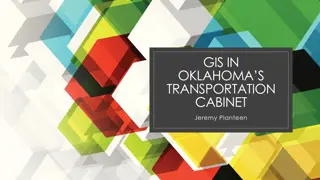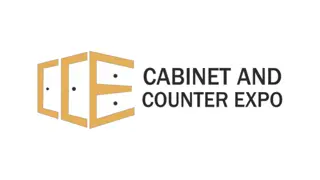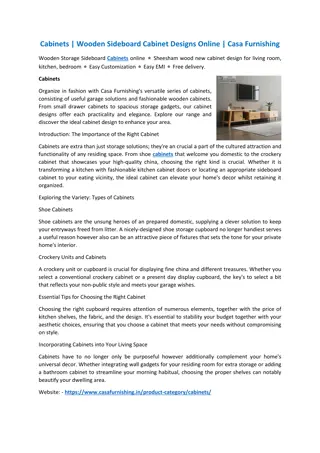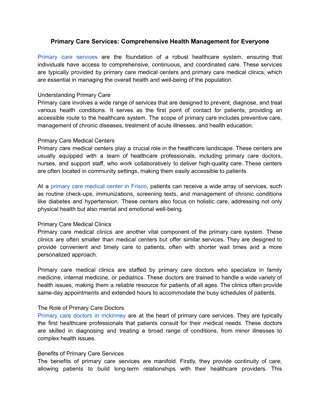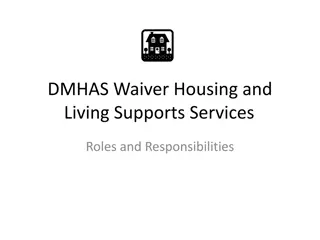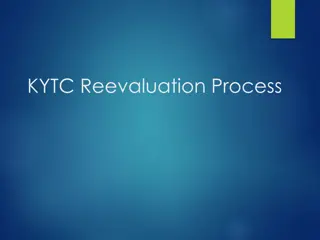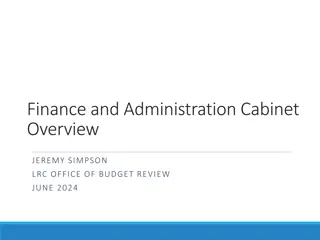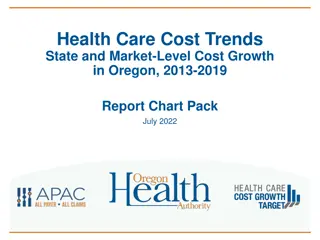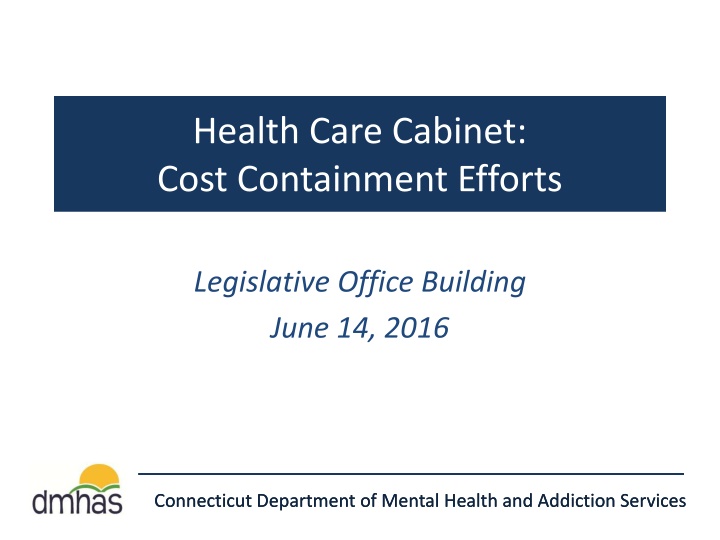
Cost Containment Strategies for Mental Health and Addiction Services in Connecticut
Learn about the cost containment efforts of the Connecticut Department of Mental Health and Addiction Services (DMHAS) to provide safety net services for individuals with complex mental health and substance use needs. Explore examples of cost drivers and solutions to address emergency department and inpatient utilization issues.
Download Presentation

Please find below an Image/Link to download the presentation.
The content on the website is provided AS IS for your information and personal use only. It may not be sold, licensed, or shared on other websites without obtaining consent from the author. If you encounter any issues during the download, it is possible that the publisher has removed the file from their server.
You are allowed to download the files provided on this website for personal or commercial use, subject to the condition that they are used lawfully. All files are the property of their respective owners.
The content on the website is provided AS IS for your information and personal use only. It may not be sold, licensed, or shared on other websites without obtaining consent from the author.
E N D
Presentation Transcript
Health Care Cabinet: Cost Containment Efforts Legislative Office Building June 14, 2016 Connecticut Department of Mental Health and Addiction Services Connecticut Department of Mental Health and Addiction Services
Summary of Mission DMHAS provides safety net services to individuals with complex mental health and substance use needs Connecticut Department of Mental Health and Addiction Services
DMHAS Overview Lead state agency for substance abuse and mental health services 110,000 adults served annually by DMHAS system of care One State hospital and 7 State-operated Local Mental Health Authorities; 3 with inpatient programs 160 non-profit agencies serve individuals with substance use and mental health services Treatment, Recovery Support and Prevention Connecticut Department of Mental Health and Addiction Services
Examples of Cost Drivers 1. Emergency Department and Inpatient Utilization 2. Skilled Nursing Facility (SNF) Care for Mental Health Clients 3. Intersection of Homelessness and Behavioral Health Connecticut Department of Mental Health and Addiction Services
Example 1: Cost Driver Emergency Department and Inpatient Utilization Connecticut Department of Mental Health and Addiction Services
Solution 1: Emergency Department Adult Frequent Visitors (an initiative of the CTBHP) Partner with 5 high volume Hospital E.D.s (Bristol, Hartford, St. Francis, William Backus and Yale); and Implement Intensive Care Management & Peer Interventions to improve connections to care, reduce unnecessary ED use, reduce recidivism/readmission Cohort: 18 years and older, visited the E.D. 7 or more times in a six month period, primary or secondary behavioral health diagnosis on the claim A total of 23,357 Adult Medicaid members (approximately 5% of the total Adult Medicaid population excluding those with Dual Eligibility) had at least one Behavioral Health ED (BH ED) visit between 1/1/14 and 6/30/14 Connecticut Department of Mental Health and Addiction Services
Estimated Costs Associated with Emergency Department Frequent Visitors Estimated Total and Average Medicaid Costs by Volume of BH ED Use 1/1/2014 - 6/30/2014 $35 k $32 k $30 k $25 k Average Spend $20 k $16 k $15 k $9 k $10 k $3 k $5 k Adult Medicaid Average $0 k No BH ED Visits One BH ED Visit Moderate BH ED Visitors (2-6 Visits) Frequent BH ED Visitors (7+ Visits) Connecticut Department of Mental Health and Addiction Services
Interventions with Emergency Department Visitors Principles of Wellness Recovery Action Planning (WRAP) & Motivational Interviewing used to engage and motivate; Work with members to assess unmet needs that result in unnecessary E.D. visits/readmissions; Development of member centric wellness and recovery goals that include connection to/engagement with community providers, resources and non-traditional supports (CCAR; AU; Journey Home); Partner with Medicaid Medical ASO, Advanced Behavioral Health, Inc. to address unmet needs. Connecticut Department of Mental Health and Addiction Services
Anticipated Outcomes Increased connect-to-care rates to behavioral health services. Decrease in 30-day inpatient readmission rates. Decrease in 90-day inpatient readmission rates. Connecticut Department of Mental Health and Addiction Services
Solution 2: DMHAS Behavioral Health Homes Eligibility: Medicaid-eligible; medical expenses that exceed $10,000 in a year; and who have a serious mental illness. Co-morbid medical conditions of eligible adults are: high blood pressure, high cholesterol, diabetes, asthma and chronic obstructive pulmonary disease. Behavioral Health Homes are currently providing care management, care coordination, health care transition support, referrals, information and support to family members and health education to over 6,700 people statewide. This includes: assessing and identifying primary care needs; developing a plan of care for these needs; connecting enrollees to appropriate treatment; then monitoring their progress. Connecticut Department of Mental Health and Addiction Services
Behavioral Health Home Goals Reduce unnecessary use of emergency departments Reduce the rate of re-admissions to hospital in patient departments Stabilize elevated blood pressures, asthma and Hb1Ac (blood sugar levels) Reduce substance use Improve connections to care Improve the percent of individuals who receive preventive care Increase person-centeredness and satisfaction with care delivery Increase connection to recovery support services Connecticut Department of Mental Health and Addiction Services
Behavioral Health Homes Cost Savings BHH will be documenting cost drivers among participants including behavioral health and chronic medical service usage and patterns of Emergency Department and Inpatient utilization. BHH short term strategies for cost containment include collaborating with statewide hospital intensive care managers to divert approximately 600 people to care in the community. Connecticut Department of Mental Health and Addiction Services
Solution 3: Alternatives to Hospitalization (ATH) Relieve gridlock in general hospital emergency depts. Decrease inappropriate use of mental health inpatient. Improve access to: appropriate substance abuse treatment Treatment of co-occurring psychiatric and substance use disorders Savings used to expand access to community care. Connecticut Department of Mental Health and Addiction Services
Alternatives to Hospitalization Partnering Hospitals in the ATH Program: Hartford, St. Francis, Manchester, Bridgeport, St Vincent s, Middlesex, Waterbury. Drivers: A total of 80% of all ATH presentations (project-to- date) had a primary or co-occurring diagnosis of substance abuse. Connecticut Department of Mental Health and Addiction Services
Alternatives to Hospitalization Connecticut Department of Mental Health and Addiction Services
Example 2: Cost Driver Skilled Nursing Facility (SNF) Care for MH Clients Connecticut Department of Mental Health and Addiction Services
Solution 1: Mental Health Waiver DSS/DMHAS Partnership on Home and Community Based Services (HCBS) Mental Health Waiver/Money Follows the Person (MFP) Designed for adults with serious mental illness (SNF discharges and diversions) CMS funds rebalancing efforts: CT s goal is to rebalance long-term care systems with an emphasis on Person-Centered Rehabilitative & Support Services that are home and community based Average costs for Nursing Home Care in CT is $87,000/year Average costs for community based care is $56,000/year (35% savings) Connecticut Department of Mental Health and Addiction Services
Mental Health Waiver Person-centered, holistic framework emphasizes wellness and recovery Intensive psychiatric rehabilitation Attention to psychiatric, substance use and medical needs Emphasizes strengths and assets & utilization of natural supports & community integration Peer supports provided by people trained and certified in rehabilitative care, who know from first-hand experience about recovery from mental illness. Connecticut Department of Mental Health and Addiction Services
Example 3: Cost Driver Intersection of Homelessness and Behavioral Health Connecticut Department of Mental Health and Addiction Services
Solution 1: CT Collaborative on Re-Entry (CCR) (formerly FUSE) Program targets individuals, diagnosed with mental illness or chronic substance abuse, who cycle through the homeless service and corrections systems Data is matched from Department of Correction and Homeless Management Information System (HMIS) to identify individuals who cycle repeatedly in and out of correctional settings and emergency shelter system Started as 30 unit pilot in 3 areas of the state, has grown to 190 units in New Haven, Bridgeport, Hartford and New London County Housing subsidies provided by Housing Authority of New Haven, Bridgeport Housing Authority and the Department of Housing Connecticut Department of Mental Health and Addiction Services
CT Collaborative on Re-Entry Outcomes: 114 individuals housed to date 90 additional slots added in October 2015 for a total of 190 units Improvements in housing status, living satisfaction, substance use, jail days, and ER/Hospital use (2013 study N=101) Connecticut Department of Mental Health and Addiction Services
Solution 2: Social Innovation Fund (SIF) Frequent users of Medicaid Services and Homeless Services determined by a data match, 160 at four sites. Employs patient navigators who assists individuals in obtaining primary care and specialty care services and offers a rental assistance subsidy. Majority of SIF clients served in Connecticut -- around 92%-- have at least one mental health or substance use condition. In fact, 66% of the population have mental health, substance use, AND chronic health conditions. Project staff also provide case management, benefits management and rep payee services. Original program did not pay for case management services. In FY 2015 DMHAS started to fund each agency approximately $7,500.00 per year/per client to augment services. Connecticut Department of Mental Health and Addiction Services
Social Innovation Fund (SIF) Outcomes: 92% housing retention rate. 90% have an active connection to a primary health care provider. 91% are actively connected to behavioral health care. 89% are connected to specialty care. Decreased use of Hospital emergency department as main source of care. Overnight hospitalizations dropped from 8.5 to 2.7 in the 12 months post supportive housing placements. Emergency department visits decreased from 13 to 5 in the 12 months post supportive housing. Connecticut Department of Mental Health and Addiction Services
QUESTIONS Connecticut Department of Mental Health and Addiction Services Connecticut Department of Mental Health and Addiction Services


